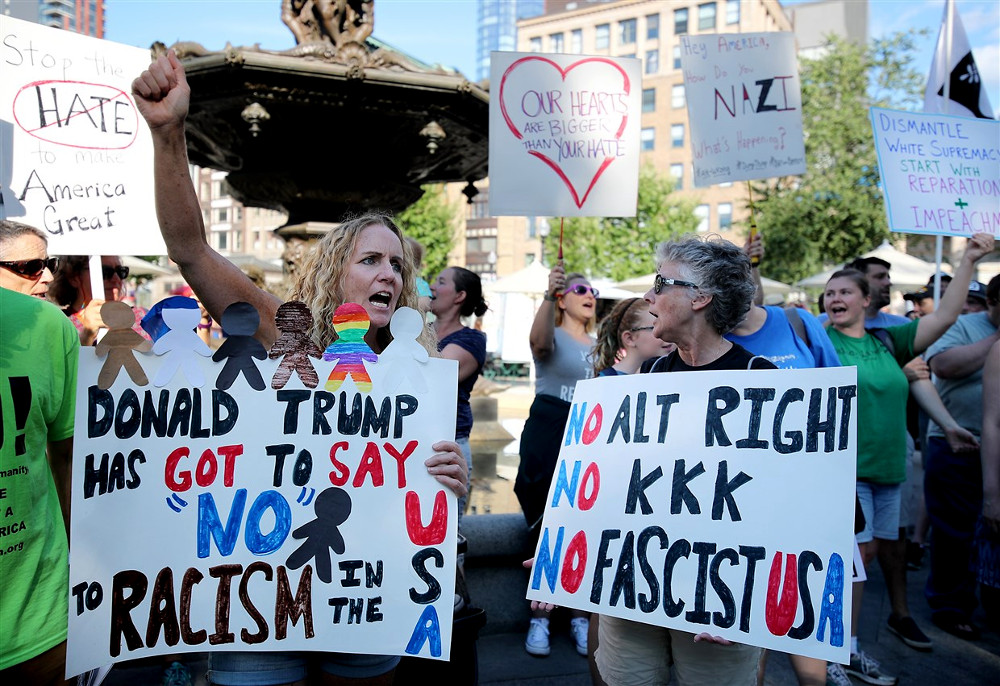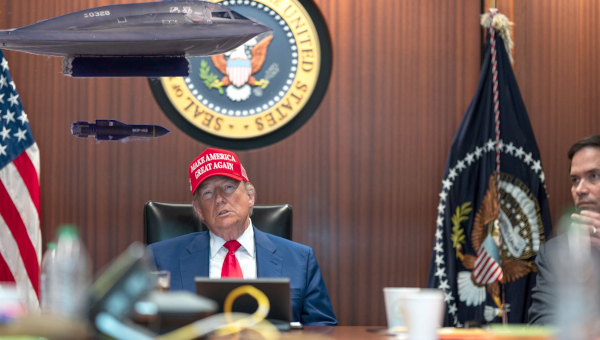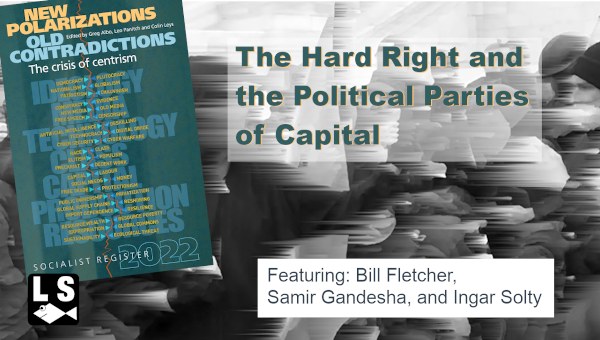Trump and the Spectre of Fascism
As a long-time educator and researcher in the Canadian labour movement, I think it is imperative at this moment that we reach out to our members and communities on the politics that has been emerging on the hard right. This includes hard right populists like Doug Ford, Jason Kenney and Andrew Scheer in the Conservative Party in Canada, but also the People’s Party of Canada of Maxime Bernier and fascist and racist groups appearing on our streets like the Soldiers of Odin, the Proud Boys and many others. Our members need to also know something of the growth of the hard right in Europe, in countries like Poland and Hungary, but also in Brazil, India, the Philippines and elsewhere. And, of course, there is Donald Trump in the US, and the growing xenophobia, anti-immigrant, Islamaphobic, and racist forces he has been empowering and encouraging, with the open racist chanting at his election rallies.
This article speaks, therefore, to issues fundamental to public life today and that we need to bring to our educational work in the trade union movement and in our community groups. We need to debate and think hard about free speech, freedom of assembly, and democratic rights versus authoritarian regimes that often attempt to deny such rights. We have to debate the ways we need to bring anti-racist, and anti-fascist work into our work, the alliances and fronts we need to form in our communities, and the platforms and politics we need to demand our union leadership develop and mobilize around. We need to help our members examine the politics of Trump in the US and compare it to the rise of German fascism in the 1930s. What is similar about them and what is different? Where does the US fit today with respect to authoritarian and militarist states? How do we understand concepts such as neoliberalism, white supremacy, populism and fascism? What strategies and tactics do we need for confronting the various mutations of the hard right today?
Our contemporary world faces a number of challenges not the least of which is the rise of Donald Trump to the American presidency. This has unleashed a range of conservative forces, inclusive of far-right groups. But is he a fascist as some people claim? It is the answer to this question that we intend to explore.
 We begin by examining the latest writing of Henry Giroux, a world-renowned educator, author, and public intellectual who has written numerous books and articles. His latest papers at the time of writing are entitled “The Nightmare of Neoliberal Fascism” (2018a) and “Neoliberal Fascism and the Echoes of History.” (2018b) Both are worth our attention as they outline a new and unique perspective of Trump’s America.
We begin by examining the latest writing of Henry Giroux, a world-renowned educator, author, and public intellectual who has written numerous books and articles. His latest papers at the time of writing are entitled “The Nightmare of Neoliberal Fascism” (2018a) and “Neoliberal Fascism and the Echoes of History.” (2018b) Both are worth our attention as they outline a new and unique perspective of Trump’s America.
According to Giroux “a distinctive economic-political formation has been produced” one he calls “neoliberal fascism.” He continues: “Neoliberalism and fascism conjoin and advance in a comfortable and mutually compatible project and movement that connects the worst excesses of capitalism with fascist ideals;…” After years of neoliberalism, Giroux believes that “the mobilizing passions of fascism have been unleashed unlike anything we have seen since the 1930s and 1940s” (2018a: 15-16).
Further, he holds that neoliberalism “creates an all-encompassing market guided by the principles of privatization, deregulation, commodification and the free flow of capital.” Promoting such an agenda he argues “weakens unions, radically downsizes and weakens the welfare state and wages an assault on public goods.”
From such economic changes neoliberalism moves to influence social life. Society itself is restructured to the dictates of profit commercializing all social interactions. The realities of competition come to the fore. Social interactions become more and more about winners and losers. Issues of equality and democracy are sidelined.
Despite Giroux’s radical critique of neoliberalism there remains a huge gap between such policies and a fascist state.
The following maps out the essence of “classical” fascism.
What is Fascism?
Many people today use the term fascist all to loosely, including my fellow trade unionists. It is seen as an epithet to be flung against rightwing authoritarian figures they don’t like. A term of general abuse against virtually any reactionary regime. It has even been used as a swear word. This usage is understandable on the one hand, but far too vague for a critical analysis on the other. When asked for a more specific response a person may well reply that fascism constitutes a dictatorship, an authoritarian regime, a military regime, a government promoting antisemitism, to name but several typical responses.
More cogent responses reference the National Front in France, the Northern League in Italy, the Party for Freedom in the Netherlands, Golden Dawn in Greece, to name a few. This trend to the political right has recently been augmented by the rise of the anti-immigrant Swedish Democrats in their 2018 election. Others note that a similar phenomenon is now seen in the United States with the rise of Donald Trump.
Yet upon a closer look fascism had specific characteristics and arose in particular historical circumstances. Not every reactionary regime is fascist. If we are to oppose such developments we need to have a clear understanding of what fascism really is. What is different about it compared to other dictatorships? Clarifying the problem can assist us in both understanding it and confronting it.
There are dozens of writers and perspectives on fascism that are available in the literature today. For our purposes fascism has most clearly been defined by Leon Trotsky. He was one of the few that didn’t just write post-mortem. Rather he diligently followed events as they occurred and constantly updated and clarified his analysis. According to Isaac Deutscher (1963), Trotsky, “Like no one else, and much earlier than anyone, … grasped the destructive delirium with which National Socialism was to burst upon the world.” The core of Trotsky’s perspective was that fascism constituted a mass phenomenon based on the middle class, backed by large capital, that sought to destroy the working class and its organizations.
Not all fascism is the same however, and certainly one can expect changes over time and circumstances. As Henry Giroux notes: “The conditions leading to fascism do not exist in some ethereal space outside of history. Nor are they fixed in a static moment in the past” (2018a). Yet surprisingly Giroux doesn’t examine fascism of the past in order to critically assess changes over time.
Exploring the past, here are several elements integral to fascism that we can summarize from Germany in the 1930s and 40s. We will then explore key contemporary changes.
- The petit bourgeoise, (middle class) rural and urban, is the social base of classical fascism, this includes not only shop keepers and peasants, but also doctors, lawyers, the upper managerial strata, other professionals and some workers. Most of these still owned, in whole or in part, their own businesses, but mobilized in mass protest given the constant threat from large scale enterprises. Yet ironically large capital backed the growth of fascist developments in the 1930s. Links that Daniel Guerin, the famous French analyst of the 1930s, quite properly refers to as between “Fascism and Big Business” (1973).
- Social crisis: fascism emerges as a social force when capitalism enters a severe national crisis (economic, political, international). Here the regime can no longer govern on the basis of granting reforms and thereby stabilizing society. Indeed, the mass petit bourgeoisie base of fascism now in “deep social crisis” is thrown off balance politically and desperately searches, to both the political right and the left, for how best to save themselves from socio-economic and political ruin.
- Ultra-nationalism leading to views of virulent racism, anti-semitism, and xenophobia, is integral to fascism. A centralized state and aggressive militarism, were fundamental to the extreme nationalism of German Fascism. A fanatical nationalism that functioned to make Germans feel superior and others (Slavs, Jews, people of colour, homosexuals, people with mental and physical disabilities, communists, and others) subordinate – if not subhuman. A rabid misogyny was also a significant component of this mix.
- Ruthless attacks on workers’ organizations and individual workers the severity and violence of which reduces the working class to an amorphous state structurally and politically. Trade unions were attacked and their elected leadership replaced by fascist supporters. This was accompanied by the crucial lack of resolute political leadership on the part of anti-fascist parties and forces. The formation of an all-important alliance – a united front – of all anti-fascist parties was not even attempted (Trotsky 1971).
These four summary points capture the essence of fascism of the 1930s and 40s. This is important if we are to heed the “warnings of the history” in order to combat such developments today and in the future.
Finally, it is worth noting that a repressive dictatorship is not in and of itself necessarily a fascist regime, but rather one that is most often based on bureaucratic institutions and reinforced by a military apparatus. It is often not based on mass middle class support so it is rarely popular in the country it rules. All this is not to say such regimes are necessarily any less dangerous, but they do have a different social base and therefore are subject to distinct pressures, levels of popular support, politics and strategies.
Currently the notion of right-wing populism is used in an attempt to describe regimes “seen as representing incipient anti-democratic, dictatorial, and even totalitarian tendencies, to be found on both right and left, insofar as they oppose liberal democracy” (Foster 2017). Once again we find a very lax usage of a term applied to a variety of regimes with only the most elemental characteristics agreed upon. Others reject the use of this characterization not only due to its lack of clarity, but most importantly given its association with the past where populism can be seen as an attempt to bring fascist ideas back into the fold of liberal democracy albeit with authoritarian tendencies. Here populism is compatible with the notion of totalitarianism as articulated by Hannah Arendt (2001).
The key concern here is that these issues, particularly that of fascism itself, have yet to be historically analyzed by Giroux. The introduction of the term “neoliberal fascism” in his work has occurred without an understanding of the four core constituent elements of classical fascism noted above or perhaps even an awareness that such an analysis exists. “Neoliberal fascism” seems to pop out of the air rather than follow a critical analysis of the past proceeding forward to the present. This is not to suggest that Giroux’s work isn’t important, indeed it is highly relevant. Yet a more comprehensive understanding of fascism yesterday could well produce a richer comprehension of fascism today. As Geoff Eley expresses it: “Knowledge of the early twentieth-century context can help with the work of theorizing the character of differing but comparable crises in the present” (Eley 2016).
The United States Today
This brief article is not the venue for a detailed and comprehensive analysis of fascism in Germany of the 1930s and 40s. The intention of the following paragraphs is to indicate the ways in which the United States is fascist or moving toward such. On the other hand, it may be more appropriate to characterize the US today as some other form of regime. The following paragraphs attempt to clarify these issues.
For a long period after the Second World War, a period often termed the post-war boom, fascism, defeated in war, seemed to recede into the historical background. Key industrial countries saw economic growth and could afford the reforms necessary to maintain stability and even prosperity for significant layers of the population. Recently however the world situation has begun to change with a number of countries experiencing what are identified as right-wing populist governments. The election of Donald Trump in the United States brought a government of this type to the fore.
A number of factors, which together are integral to a definition of fascism, are visible in the United States today, while others are absent:
1. The above discussion is largely a comparison of the United States and 1940s Germany. Yet although this period in the United States reuses imagery from Europe, the fundamental roots of the current rightward drift of American politics are found in its settler-colonial origins and notions of white supremacy. This racial perspective is obvious to many aboriginal Americans and African-Americans. It is also observable in Trump’s attitude toward the caravan of thousands of migrants walking from Central America to the United States.
2. For all the budget controversies and political turmoil in the United States the above social classes and groups have not experienced a major and shattering social crisis. A severe depression with mass unemployment of the 1930s vintage has not transpired, although there have been recessions right into the 21st century. Nor have the deprivations of war as a mass phenomena been experienced since World War II. In contrast, in the 1930s, Germany’s disaffected lower and middle classes rose up in anger over their desperate life situation and the punitive accords of the Versailles Treaty.
Recessions have occurred in the United States and hardships for sectors of the work force have been virtually commonplace over time yet as noted above, the economy has not crashed throwing tens of millions out of work as in post-World War 1 Germany. There has been no mass middle class population turning to fascism, although there is a growth of what is termed the alt-right it is of yet far from a mass phenomena, if not peripheral.
3. There has been a growth of virulent nationalism with Trump repeatedly chanting his electoral slogan of “Make America Great Again” and his protectionist insistence on “America First.” With his authoritarian bullying, with his support for white supremacy, exposed in his comments and actions regarding the racist demonstrations and violence in Charlottesville, Virginia, there are echoes of Hitler’s Germany with its physical violence and virulent ultra nationalism, xenophobia, and antisemitism (Woodward 2018).
Within weeks of his election Trump issued an executive order banning Syrians and people from seven other Muslim majority countries from entering the United States. Protections for children who have grown up in the United States although born in other countries – 800,000 Dreamers – were cancelled by Trump. It is easy to see these racist moves as fascist-like. They certainly could be seen as demonstrating an ideology of ultra nationalism and white supremacy.
Nonetheless, the structure of US politics has remained with regular two-party elections federally and on the state level. The centralization and dictatorship of Hitler’s Germany has to date not been replicated. For all of Trump’s talk about “fake news” the same news channels that were operative before his election, remain today despite his attacks on the media. He is also in ongoing conflict with state security, intelligence and defence apparatuses. Equally significant is his erratic conflict with his own executive.
4. As could well be expected, Trump is hostile to worker’s organizations and is particularly opposed to the trade union movement. To date this has not been a major problem for him as union density in the US has dropped dramatically to under 10 per cent of the workforce. There has therefore been little reason for Trump to attack unionized employees. In Hitler’s Germany the trade union movement was dominated by his political opponents in the Social Democratic and Communist parties. Despite their antagonistic relationship, in the end these political parties were largely ineffectual in opposing Hitler. Indeed, their failure was key to the success of fascism.
On the other hand the trade union movement in the US has been particularly noticeable not by its opposition but by its absence, its silence, and abandonment of leadership against right wing policies. Nor has there been any other major working class groups actively opposing him. True, there have been anti-racist and anti-Trump demonstrations, but without a severe economic and social crises society has remained relatively stable. Despite the reality of divisions and political tensions in the United States the period of consensus politics is highly troubled, but not necessarily over.
Conclusion
On balance, Trump’s America is more and more authoritarian. In the past, where a stalemate existed between major classes, it would have been termed a “Bonapartist” regime. This is not the case today where the dominant class is in full control despite being split on tactical issues. Many of the factors of a “classical” fascist regime are not currently present in the United States. It is these key factors that together define a fascist regime albeit with significant modifications given contemporary circumstances and politics. Yet it is also true that with Trump, American policy has moved more and more in an ultra-conservative direction. The ideology of white supremacy and racist views, seen for example, in the Charlottesville demonstration and in Trump’s response to the caravan of desperately poor people walking from Central America through Mexico to the American southern border, provide demonstrative evidence.
If the United States is not fascist, how should it be characterized? Many commentators today, as noted earlier, use the term populism or rightwing populism in an attempt to capture the essence of regimes with popular support and that challenge liberal democracy. This term could be applied to a number of otherwise distinct regimes. Thus, we noted the vagueness of this characterization which makes it inappropriate for gaining clarity.
Combining the notion of neoliberalism and fascism as Giroux does, is also problematic. Neoliberalism has been the dominant form of capitalism for several decades. Privatization, deregulation and the increasingly free flow of capital, in part captured in free trade agreements, are aspects of economic life one may disagree with but they are a far cry from a dictatorial regime.
In contrast, the triumph of fascism would require a seizure of the entire state apparatus and the end of any real separation of powers between the various organizations of government – local, state and federal (House of Representatives, Senate and the White House). It would also mark the end of freedom of speech. It is for this reason the two notions should not be combined. They are very distinct and consequently require very different approaches politically.
One can certainly say that the current American regime is increasingly authoritarian and harbours views that are compatible with – and empower – fascism such as “America First,” ultra nationalism, white supremacy, xenophobia, Islamophobia and antisemitism. Yet as of now these reactionary views are subject to opposition and relatively democratic elections. The growth of a broad resistance with organizational structures that unite diverse forces, known as a united front, can form a powerful opposition to the authoritarian “neofascist wind” blowing in contemporary America. As Naomi Klein (2017) expresses it: “No is not enough.” Resistance is necessary. •
References
- Hannah Arendt (2001) The Origins of Totalitarianism, New York: Houghton Mifflin Harcourt.
- Issac Deutscher (1963) The Profit Outcast: Trotsky: 1929-1940, London: Oxford.
- Geoff Eley, “Fascism Then and Now,” Socialist Register 2016.
- John Bellamy Foster, “This is Not Populism,” MR Vol. 69, No. 2, June 2017.
- Henry Giroux, (2018a) “The Nightmare of Neoliberal Fascism.”
- Henry Giroux, (2018b) “Neoliberal Fascism and the Echoes of History.”
- Daniel Guerin, (1973) Fascism and Big Business, New York: Monad.
- Naomi Klein (2017), No is Not Enough, Toronto: Alfred A. Knopf.
- Leon Trotsky (1971) The Struggle Against Fascism in Germany, New York: Pathfinder Press.
- Bob Woodward (2018) Fear: Trump in the White House, New York: Simon & Schuster.





